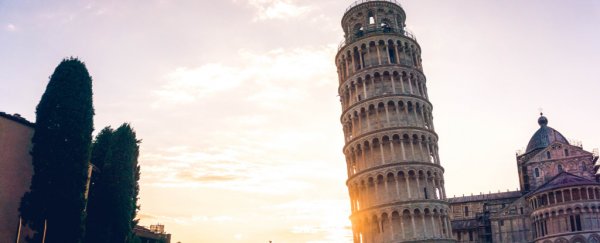The Leaning Tower of Pisa is one of the world's most iconic structures. But there was a time when its distinctive tilt was so extreme, experts were worried the structure would soon collapse, and so a plan was carried out to pull the tower further in line.
Those efforts ended back in 2001. Since then, the building has continued to straighten, with new data saying the tower as recovered around 4 centimetres (1.5 inches) or about half a degree of lean.
(But don't worry – you can still pretend it was you who did all that work by having your photo taken pushing against the ancient structure.)
Of course, it's still not straight. Nobody would want to visit the Perfectly Perpendicular Tower of Pisa after all.
But the surveillance group responsible for monitoring the tower's lean have declared the tower has returned to stability.
"It's as if it's had two centuries taken off its age," says the president of the commission to save the tower, Salvatore Settis, as reported by the BBC.
Which, given the bungled attempts to fix the problem in the past, means we're back to square one. Yay … I guess.
Since the famous bell tower's construction in 1173, it's been a bit wonky.
Engineers working on its construction didn't quite realise the sand and clay foundations were softer to the south, causing one side of the building to sink more than the other. This is why we need geologists, people!
By the time the third story was being added, it was clear something was wrong. Rather than abandoning the whole project, five more levels were added off centre, creating not just a leaning building, but a slightly curved one.
It's possible somebody might have been thinking of the key chains they could sell, but in all likelihood nobody expected the 56 metre (183 foot) tower to continue to topple over the next eight centuries, dragging it roughly 5 metres (16 feet) from the vertical.
This was a win for ball-dropping physicists keen to test gravity, and a win for tourists who want a shirt that reads 'I climbed all 296 steps and all I got was this lousy t-shirt', but there's only so far a tower can lean before catastrophe strikes.
In 1838, the architect Alessandro Della Gherardesca figured it might help if the foundations were exposed. He was wrong. Very wrong. He just made it worse.
Oops.
The famous dictator Mussolini thought it was an embarrassment, so ordered a bunch of holes to be drilled around it and concrete poured in.
He also made the problem worse.
In 1990, a year after the collapse of another famous Italian medieval bell tower took the lives of three tourists, public officials closed the tower doors and set about fixing these monumental errors once and for all. Enough was enough.
Engineers removed its heavy bells and wrapped cables around the third level before anchoring the building to the north.
The next step was to remove sand, water, and clay from the north side and using giant lead weights to push the foundations down into the hollow while reinforcing them with concrete.
This stage was super slow going. It took about a decade and cost around 30 million Euro, but succeeded in taking 200 years off the clock and recovering a whole 50 centimetres.
Over the next decade the tower has continued to slowly settle, shifting another few centimetres (about an inch) on its own.
In 2007, Settis feared if nothing had been done, the tower almost certainly wouldn't be around for our grandchildren.
"If we had not stepped in the tower would have collapsed between 2030 and 2040," he told The Telegraph at the time.
The bell tower is now back to its pre-Gherardesca position, and doesn't seem set to move a great deal more in either direction. In the very least, we now have well qualified experts keeping a careful eye on it.
The monument has survived a handful of earthquakes. Botched engineering jobs. And the grind of millions of tourist feet. It deserves stick around a few more centuries at least.
With word that it's now stable, hopefully its doors will stay open for a while to come. Which is great. I want my t-shirt.
